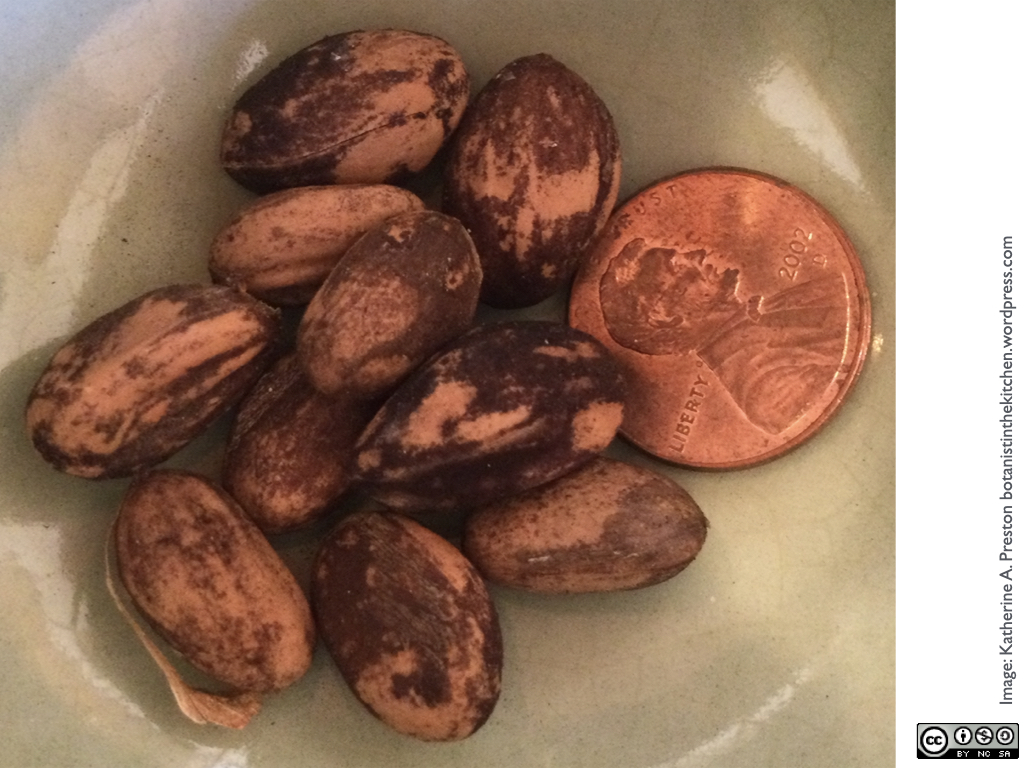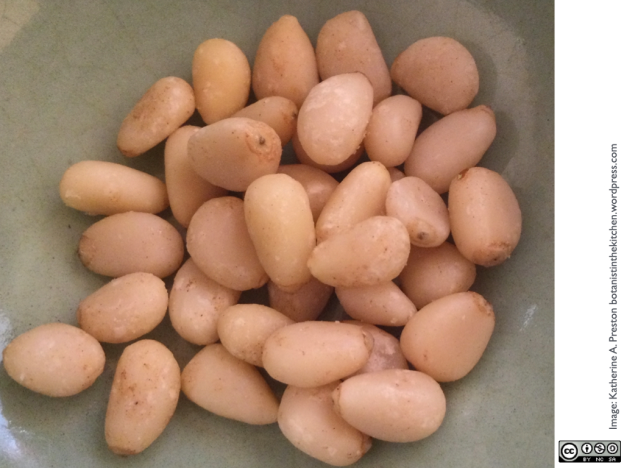It’s the winter holiday season, when halls are bedecked with garlands of evergreens, sprigs of holly, and bunches of mistletoe to remind us that there is life in the darkness and love to be shared. This year, Katherine has added another symbolic plant to her own holiday list – pine nuts. They are more precious this year than ever.
I first started using pine nuts in holiday baking for the simple reason that they taste like pine and thus add a Christmas-tree note that almonds do not. A deeper significance was not on my mind. But pine nuts are so interesting botanically that I always slice some of them open to look for tiny pine embryos inside, and that triggers some nostalgia for conifer week in the botany lab I taught as a graduate student (along with the best co-TA ever). Specifically, I think about an odd conversation with one of the students, which for years was nothing but another funny story. Only now, decades later, do I understand that this student’s observations have something to teach us about the true meaning of pine nuts.
The remarkably unfiltered conversation happened after our student, while dissecting a pine nut, had experienced a double epiphany: he finally understood the details of sexual reproduction in pines, and he therein discovered a pathetically apt metaphor for his love life. I can still see the way he dropped his shoulders as dejection slid across his face. His exact words are lost after so many years, but he basically confided to us that, like a pine seed, he always invested a little too much and a little too early in the promise of love (or at least sex) which might never be fulfilled.
Lessons from pine sex
Both pines and flowering plants make seeds, however they don’t feed their embryos the same way. Pines (and other gymnosperms) pack a fat lunch in anticipation of an embryo, whereas flowering plants typically wait for successful fertilization and only then build up a food reserve for the embryo. Pines invest in an uncertain future, while flowering plants hold back and hedge their bets. Our student thought that his was a losing strategy, and that he should behave more like a flowering plant, but I’m not sure. I like to imagine that someone found his earnest vulnerability charming, and that he has found the loving partnership he was looking for. No matter what happened in his case, however, this I now know for certain: sometimes in life you have to muster the courage to invest fully, even recklessly, in hope. I think that’s a pretty good message for the short days of winter.
The full story of pine reproduction starts with the story of seeds, which is very complicated and still not fully resolved, but here it is in a nutshell. Seeds were an incredibly successful evolutionary innovation because they took a process that depended on wet soil or water pooling on bark or in sidewalk cracks and brought it inside a protective shell that remained on the parent plant and could function without free water. The ancestors of seed plants were similar to today’s ferns, in that they shed spores that germinated in moisture and grew into tiny plants that made eggs and swimming sperm. There are variations on this basic system throughout the plant kingdom, but ferns are a familiar example. In ferns, the large frondy generation is called the sporophyte (“spore plant”) because it makes spores. (Spores result from meiosis, so they contain half as many chromosomes per cell as the sporophyte does). Spores germinate and grow into flat green plants about the size of a lentil. These are called gametophytes because they make gametes (eggs and sperm). Under the right conditions, eggs and sperm meet, and the result is a new sporophyte.

Pine trees are also sporophytes, but they hold onto their female spores, which develop into egg-producing female gametophytes* inside the seeds on the scales of their cones. The male spores are shed as pollen grains, with sperm-producing cells inside. Whereas free-swimming fern sperm cells get nowhere without a film of water between themselves and some eggs, pine sperm packaged into pollen grains can float through the air towards more distant eggs. Although non-seed plants have done well evolutionarily – mosses and ferns are especially diverse, widespread, and abundant – the seed habit has freed gymnosperms and angiosperms from some ecological constraints and has undoubtedly contributed to their success in a range of habitats.
What is a pine nut?
For all its oily goodness, botanically a pine nut is not a nut at all. It is a seed, and without its shell (the seed coat), a pine nut is essentially nothing but female gametophyte, often with a cute little embryo inside bearing tiny pine needles. Long before it gets to that point, however, the gametophyte has to do what its name calls for – it makes eggs, two of them – and it also accumulates a lot of nutrients for a potential embryo. A typical commercial pine nut is about two-thirds fat by weight and one-third protein and carbohydrates. A tree invests in making hundreds or thousands of those energy-rich structures each season, even though only some of the eggs will be fertilized. I don’t know what proportion of the ovules (immature seeds) are actually fertilized on a typical tree, but in a bag of pine nuts it is sometimes hard to find any with an embryo inside. Other times, most of the seeds I open up do contain baby pines.
Pine nuts are worth dissecting in your kitchen because they give you a rare glimpse into the evolutionary history outlined above. By contrast, you will never see the female gametophyte of a walnut, pecan, almond, hazelnut, peanut, or cashew, at least not in your kitchen. In flowering plants, the female gametophyte has evolved to be just a handful of cells, and when we eat an angiosperm seed, we are eating some combination of embryo and that special made-just-in-time tissue called the endosperm.
Conifer week in your kitchen
Just for auld lang syne, I gathered and photographed some of the materials we might have used during conifer week in botany lab so that you can follow along at home. If you have your own pine nuts, that’s even better. Epiphanies are encouraged but not required.
Commercial pine nuts are harvested from natural stands of a few large-seeded species. European pine nuts come from the Italian stone pine, Pinus pinea, which is planted as an ornamental in other Mediterranean type climates, including, fortunately, the campus of Stanford University where I teach. Squirrels are also a conspicuous part of the flora and fauna at Stanford, and they had already taken most of the seeds out of the cones that I picked up. In fact, pine nut processors usually harvest cones directly from the tree before their scales have opened up, and the cones are allowed to dry at a safe distance from seed predators. Unfortunately, the remaining seeds I found, stuck inside their cones and spurned by the squirrels, had become moldy, so all the photos here of gametophytes and embryos are from pine nuts I bought. Those were harvested in China and came from a different species, the Korean pine (Pinus koraiensis).
For most of their development – between pollination and seed release – pine cones keep their scales tightly closed. You can usually find cones in various stages of development on a tree because the whole process can take two or three years. When seeds are mature, the scales of most species open up, and the seeds can be seen peeking out from between them.
In pine species with small seeds, there is a prominent wing on each seed, and seeds flutter out away from the parent plant. Italian stone pines have very large seeds whose useless vestigial wings detach from the seeds easily.

The “shell” of a pine nut is nothing but a hard thick seed coat, its only protection against the outside world. This is what it means to be a gymnosperm — a naked seed. By contrast, the shells of other “nuts,” like pecans, almonds, or pistachios are part of the angiosperm fruit wall that surrounds the seeds, and their seed coats are very thin.

Most pine nuts are sold as bare gametophytes, without their seed coats. If you look at their pointed tips you can see a small opening where the pollen grains would have settled in to germinate and send out their pollen tubes. Pine gametophytes make two eggs in special chambers (archegonia), but usually the first egg to be fertilized is the only one that ultimately develops. I have never found twin embryos inside a pine nut, but it does happen. Twinning can also result when one embryo splits lengthwise early in development.

If you have any pine nuts to dissect, it’s best to use a razor blade because kitchen knife blades are a little too thick to do the job without mangling the embryo. A longitudinal section starting at the pointed tip reveals the embryo inside.

Here’s where it gets really interesting. Recall that one of the main functions of the female gametophyte, besides making the eggs, is to nourish the embryo. In other words, once the embryo starts to grow, it basically eats the gametophyte. It does this with the help of the suspensor, a column of disposable embryonic cells that push the main part of the new plant forward, into the gametophyte, so that it can absorb its nutrients. Once the embryo has established a distinct leafy end and root end, the root starts to grow back towards the suspensor and it crushes it. You can usually find the stringy dried up suspensor in the mature pine nut.

One of the things that makes pine nut embryos so adorable is the set of tiny needle leaves at their tips. When the embryo becomes a seedling, these will emerge to photosynthesize and take over the job of feeding the young plant.

Pine nuts at Christmas
Italian stone pines (Pinus pinea) are native to the European side of the Mediterranean coast. In Italy they occur on the northern half of both sides of the peninsula and in the heel of the boot. The range continues westward along the southern coast of France and into Spain and Portugal where native stands are scattered throughout the interior (Viñas et al., 2016). Pine nuts were never domesticated and are generally not even cultivated in orchards. They are usually harvested from natural stands, as they have been for tens of thousands of years in Southern Europe. There is even evidence from a Spanish cave that Neanderthals collected and presumably ate P. pinea seeds (Finlayson et al., 2006). Modern humans kept up the practice and many traditional foods from the region feature pine nuts.
Pine nuts have a distinctive conifer flavor dominated by pinene, limonene, hexanal, camphene, and careen (McGee, 2020), and they work well in both savory and sweet dishes where they hold their own against strong herbs and spices. There is of course pesto from Genoa in the heart of pine nut country, but also Italian cakes (pinolata) and Christmas cookies (pignoli). A specialty in parts of Provence is the sweet tarte aux pignons . In Catalonia, All Saints Day (November 1) is celebrated with pine nut confections called panellets. None of these traditional recipes includes chocolate — likely because they predate its arrival into Europe — but I really like to bake with a combination of chocolate, orange, and pine nuts, especially at Christmas.

Investing in pine nuts
For a pine tree, the substantial energy allocated to female gametophytes is an investment in potential offspring with no guarantee of success. For us, it can be a substantial financial investment that may be increasingly costly for people and the planet as well. Pine nuts have always been more expensive than peanuts or almonds, but their price jumped this year for a variety of reasons (Produce Report). Most pine nuts for sale in the United States come from stands of Korean pine growing in China. There, as everywhere, pine nut processing is unusually labor intensive and even dangerous, as rough heavy cones must be harvested by hand by skilled pickers who can navigate among the branches high above the ground. Seeds are then separated from the awkwardly knobby cones and the seed coats are removed from the female gametophytes. Pandemic-related safety measures and labor shortages have limited production, and the supply chain has been throttled, driving prices even higher. Meanwhile, a warming climate and a damaging insect pest have reduced yields (El Khoury et al., 2021). I’ll confess that I balked at the cost and used local pistachios in place of pine nuts in much of my baking this year.
The more I read about pine nut production the more concerned I became about worker protections and whether pine nut harvesting in natural stands could be sustained in the face of rising global demand. A conservation biologist working in Korean pine forests in Russia has written movingly about these highly diverse and fragile ecosystems, home to rare Amur tigers and other animals, and called for protections (Slaght, 2015).
Since a few western North American species produce large edible seeds, I looked for local harvesters who intentionally support both human and ecological communities. There are at least a couple of them, but neither had any product to sell this year. The future doesn’t look good for these businesses either, given the west’s megadrought and competition from lower-cost Chinese producers. Theirs is an investment against the odds and in favor of conserving an important cultural and ecological heritage.
The message of the pine nut
Besides their piney flavor and rich texture, what can we take from the precious little naked gametophytes that are now on my list of holiday plants? What message do I send to friends and colleagues along with my chocolate orange pine nut cake?
Pines have been around for about 150 million years, and conifers for twice that long (Rothwell et al., 2012, Jin et al., 2021), so their reproductive strategy can’t be that foolish. Their lineage persisted even when an asteroid slammed into our planet, causing the fifth mass extinction. If they don’t survive the Anthropocene, it won’t be because of their sex life. If anything, we should take their lesson to heart now more than ever. We can’t afford to wait until the last minute, like angiosperms do, to invest in future generations. It is time — past time, actually — to muster the courage and the will to dedicate all the resources we can to the preservation of the planet and our place in it. Otherwise, what hope do we have?
*note: Female gametophytes are more accurately called megagametophytes, and they derive from megaspores produced in megasporangia. Male gametophytes are really microgametophytes, pollen grains are microspores, and they are shed from microsporangia. In flowering plants, microsporangia are inside the anthers.
References and further reading
von Arnold, S., Clapham, D., & Abrahamsson, M. (2019). Embryology in conifers. Advances in Botanical Research, 89, 157-184.
El Khoury, Y., Noujeim, E., Bubici, G., Tarasco, E., Al Khoury, C., & Nemer, N. (2021). Potential Factors behind the Decline of Pinus pinea Nut Production in Mediterranean Pine Forests. Forests, 12(9), 1167.
Finlayson, C., Pacheco, F. G., Rodríguez-Vidal, J., Fa, D. A., López, J. M. G., Pérez, A. S., … & Sakamoto, T. (2006). Late survival of Neanderthals at the southernmost extreme of Europe. Nature, 443(7113), 850-853
Jin, W. T., Gernandt, D. S., Wehenkel, C., Xia, X. M., Wei, X. X., & Wang, X. Q. (2021). Phylogenomic and ecological analyses reveal the spatiotemporal evolution of global pines. Proceedings of the National Academy of Sciences, 118(20).
McGee, H. (2020). Nose dive: A field guide to the world’s smells. New York, NY: Penguin Press.
Meade, L. E., Plackett, A. R., & Hilton, J. (2021). Reconstructing development of the earliest seed integuments raises a new hypothesis for the evolution of ancestral seed‐bearing structures. New Phytologist, 229(3), 1782-1794.
Pine Nut prices reach record high. Produce Report. (2022, April 5). Retrieved December 15, 2021, from https://www.producereport.com/article/pine-nut-prices-reach-record-high
Rothwell, G. W., Mapes, G., Stockey, R. A., & Hilton, J. (2012). The seed cone Eathiestrobus gen. nov.: fossil evidence for a Jurassic origin of Pinaceae. American Journal of Botany, 99(4), 708-720.
Rudall, P. J. (2021). Evolution and patterning of the ovule in seed plants. Biological Reviews, 96(3), 943-960.
Slaght, J. C. (2015, October 19). Opinion | Making Pesto? Hold the Pine Nuts. The New York Times. https://www.nytimes.com/2015/10/19/opinion/making-pesto-hold-the-pine-nuts.html
Viñas, R. A., Caudullo, G., Oliveira, S., & de Rigo, D. (2016). Pinus pinea in Europe: distribution, habitat, usage and threats. European Atlas of Forest Tree Species; European Commission: Brussels, Belgium, 204.





















